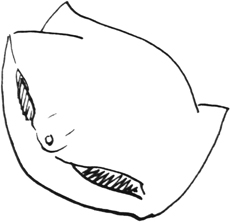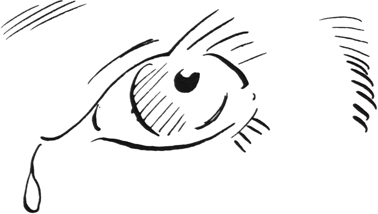
The Features

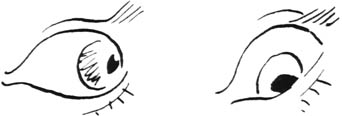
The eyes are brown or black or blue
Or grey, and of them there are two.
They are arranged beside the nose,
One to each side, which, I suppose
Was done because no other place
Was vacant in the human face.
How helpfully eyes scan the dish
And watch for bones when eating fish,
Or with a side glance, indirect, eyes
Warn us of grease spots on our neckties.
Then, eyes are used to show our feelings,
In place of yells and sobs and squealings.
For instance, to express surprise,
You raise the lids and pop the eyes;
In showing grief, the lids are dropped
And tears (if any) gently sopped
Up with a handkerchief—a white one
(And preferably clean) ’s the right one.
The eyes are cleverly equipped
With little lids, which can be flipped
Up in the morning, down at night,
To let in or shut out the light.
We could fill pages with our cries
Of admiration for the eyes;
They’re indispensable (see above).
True, eyebrows are well spoken of;
The ears are hard to do without;
The nose is useful too, no doubt;
But eyes! Do not dispense with those!
Abandon ears; give up your nose;
But we most earnestly advise:
Hang on most firmly to your eyes.
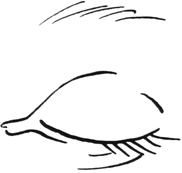
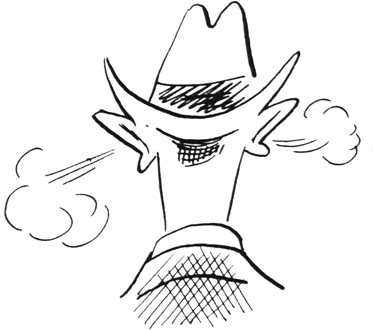
The ears are two in number, and
Beside the head, on either hand,—
One to the left, one to the right—
They are attached extremely tight.
Their purpose is twofold, to wit:
To give the hat a place to sit,
So that it will not lose its place
And, slipping down, engulf the face.
Also to ventilate the brain,
When heated by great mental strain,
By standing at right angles out
To catch whatever wind’s about,
Or when the summer breeze is napping,
To substitute by gently flapping.
Do not, therefore, attempt to pull
The ears from off the parent skull.
Though ears look odd and out of place,
And add so little to the face,
Though as adornment they’re lamentable,
Without them you’d be unpresentable;
And he who rashly grabs the shears
Will find too late, with bitter tears,
That there’s no substitute for ears.
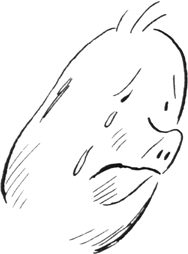
|
|
The nose, in general, finds its place
About the center of the face,
Continuing the forehead south
Between the eyes, down towards the mouth,
Above which, usually it
Stops short, in order not to hit
The chin, which in its normal place
Below the mouth, completes the face.
(Though here of ears we make no mention,
They are well worthy of attention.)
And thus we see, by its position,
The nose has an important mission;
For, gathered round it in a troop,
The other features thus can group
Themselves upon it, each in place
Symmetrically to form a face.
Without a nose to rally round
The other features would be bound
To wander off in all directions
And with the face lose all connections.
Without a nose, I rather guess
Your face would be an awful mess.
A nose, too, if not badly bent
Can be a handsome ornament
Which one can wear with joy and pride,
So do not lay your nose aside.
Preserve your nose at any cost;
You can’t replace it if it’s lost.
And wear it in its normal place,
Right in the middle of your face.
|
|
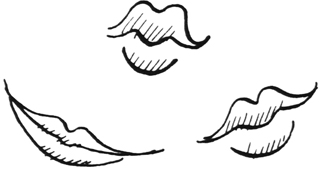
The mouth is located below
The nose, and is constructed so
That when it grins, it stretches wide
To touch the ears on either side.
This elasticity is handy
In eating pie, or hunks of candy.
Though hunks that stretch the mouth too tight
(By some considered impolite)
Require much earnest concentration,
And interfere with conversation.
In fact, there are extremely few
Who can, with charm, both talk and chew.
It’s best to keep the two things separate;
When dinner’s served, just salt and pepper it,
And for your conversation wait
Until there’s nothing on your plate.
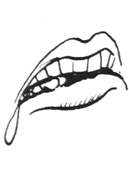
|
|
Proceeding south upon the face
The forehead first takes up some space,
Beneath which you will find the eyebrows
And then the eyes (called “orbs” by highbrows).
Along the nose continue south
And presently you reach the mouth
And see, beyond, on the horizon,
The chin’s bold promontory risin’.
Consider, then, the chin. Although it’s
Never been praised by famous poets,
Yet do not sneer at it, nor scoff,
And never, never chop it off,
For if removed, the face is shortened,
The mouth no longer looks important
But rests directly on the collar—
Which makes the public laugh and holler.
For with no chin you’d be no vision
Of beauty. You’d invite derision.
You’d look half-witted; you’d look funny;
No one would ever lend you money;
And dentists, putting in a filling,
Would have no place to lean when drilling.
The chin is used in mastication;
Thrust out, it shows determination;
And other uses I could mention—
But I’m afraid that your attention
Is wandering. Confidentially,
This verse is even boring me.
As for the chin, I must admit
I’m getting good and sick of it.
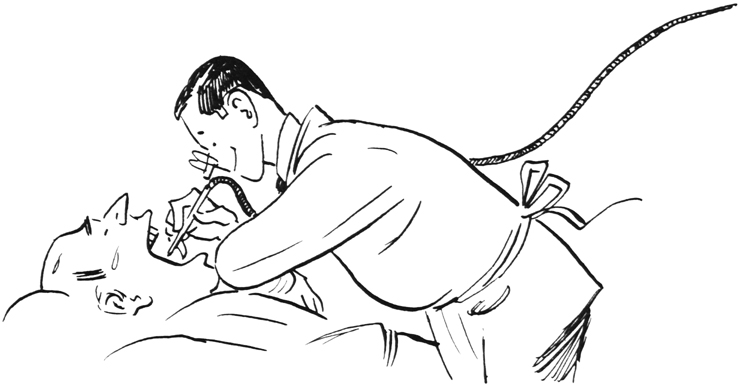
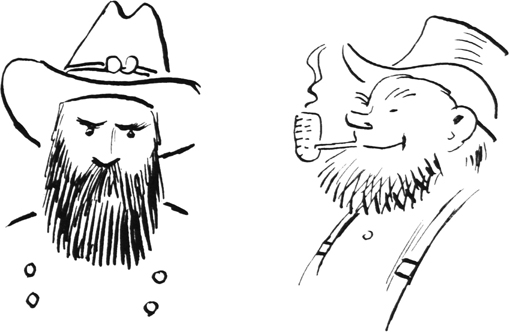
The whiskers on some men are quite
The most important things in sight.
On Mr. Bean or General Grant.
Among the foliage you can’t
Tell ears from eyes or mouth from nose;
The beard among the features grows
Luxuriant, it overflows
The chin, cascading down the chest,
Conceals the collar, tie and vest.
(Were I with whiskers so bedecked, I
’d never, never wear a necktie.)
But there are dangers to be feared,
For of one aged man I’ve heerd
Who had a most enormous beard
And chipmunks, mice and other creatures,
Who ventured in among his features
Got lost among those bushy cheeks
And wandered there for weeks and weeks.
Yes, some, they say, went in and then
Vanished, were never seen again.
Such stories, though, can hardly be
Accepted unreservedly.
It’s possible, of course, they’re true;
For one bewhiskered gent I knew,
A traveling man from Kalamazoo,
Who used his beard to keep things in—
His pipe, tobacco, and a tin
Or two of Portuguese sardines,
Boxes of crackers, cans of beans,
And several current magazines.
When traveling on local trains,
In steamships or in aeroplanes,
His simple wants he kept supplied
With what he had concealed inside
That whiskered shade—as gum, or smokes,
Light lunches or a book of jokes.
Thus were his lonely journeys cheered—
But that’s enough about the beard.
|
|
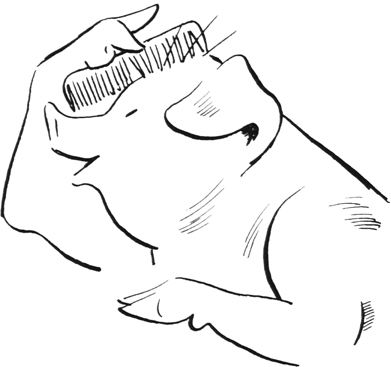
The hair is an adornment
Which grows upon the head;
It’s black or yellow, brown or grey,
Occasionally red;
But never blue or green or puce;
Such colors would look like the deuce.
That’s just one pig’s opinion—
Some have a preference
For hair that’s not so usual,
For colors more intense.
They go for violet or carmine,
And think that pink is simply charmin’.
So if you’re really anxious
To change to green or red,
Just tell your barber what you want
And when he soaps your head,
The functionary who shampoos you
Will tint your hair light blue or fuchsia.
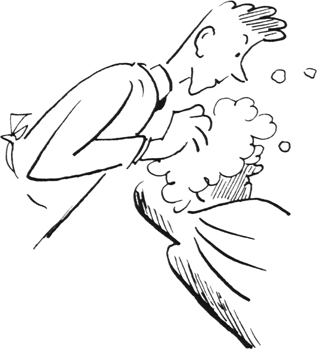
Aside from being pretty
The hair can be of help
If someone bangs you on the head
So hard it makes you yelp!
If you have hair that’s thick and tangled
You’re not so likely to get mangled.
Without hair you’d look funny,
And rather like a squash,
And every morning you would have
A lot more face to wash.
Your face would go up past your forehead,
And you’ll agree that would look horrid.
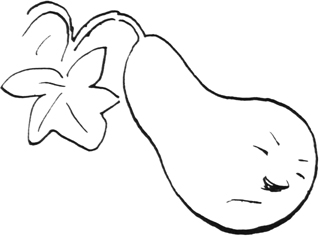
Grass only grows in summer,
Hair grows the whole year through;
It must be mowed quite frequently,
And raked twice daily, too.
Your hair (called “locks,” and sometimes “tresses”)
If never combed, an awful mess is.
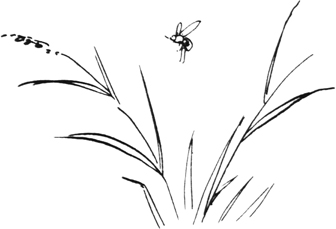
Yet some folks never cut it—
Prefer to let it grow.
This has advantages of course,
And even though it’s slow,
In time they get enough to fill a
Small mattress, or to stuff a pillow.
